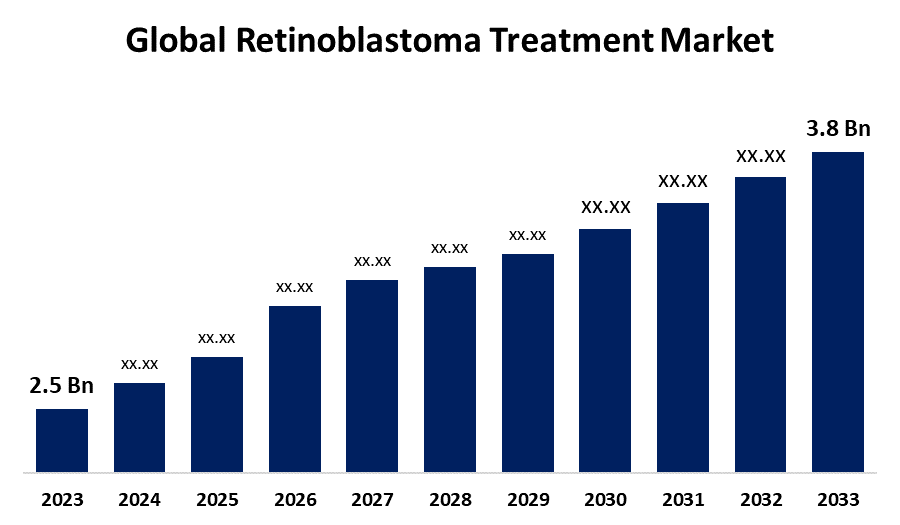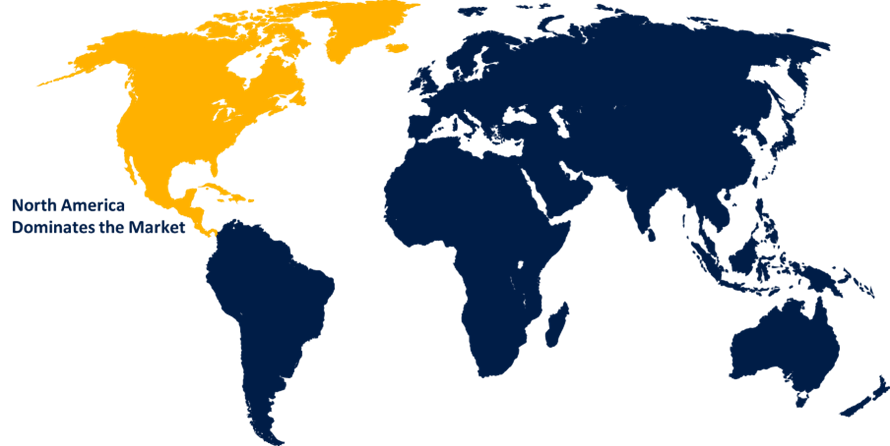Global Retinoblastoma Treatment Market Size, Share, and COVID-19 Impact Analysis, By Treatment Type (Surgery, Radiation Therapy, Laser Therapy, Cryotherapy, Chemotherapy, Bone Marrow Transplantation/Stem Cell Transplant and Targeted Therapies & Gene Therapy), By Type of Retinoblastoma (Non-Hereditary and Hereditary Retinoblastoma), By Type of Staging (Intraocular Retinoblastoma and Extraocular Retinoblastoma), and By Region (North America, Europe, Asia-Pacific, Latin America, Middle East, and Africa), Analysis and Forecast 2023 - 2033
Industry: HealthcareGlobal Retinoblastoma Treatment Market Insights Forecasts to 2033
- The Global Retinoblastoma Treatment Market Size was Valued at USD 2.5 Billion in 2023
- The Market Size is Growing at a CAGR of 4.28% from 2023 to 2033
- The Worldwide Retinoblastoma Treatment Market Size is Expected to Reach USD 3.8 Billion by 2033
- Asia-Pacific is Expected to Grow the fastest during the forecast period.

Get more details on this report -
The Global Retinoblastoma Treatment Market Size is Anticipated to Exceed USD 3.8 Billion by 2033, Growing at a CAGR of 4.28% from 2023 to 2033.
Market Overview
Retinoblastoma is a disease in which malignant (cancer) cells form in the tissues of the retina. It is a pediatric cancer that requires careful integration of multidisciplinary care. The primary goal of retinoblastoma treatment is to save the patient's life and preserve useful vision. The six types of standard treatments used are cryotherapy, thermotherapy, chemotherapy, radiation therapy, high-dose chemotherapy with stem cell rescue, and surgery (enucleation). Oncolytic virus therapy treatment uses a virus that infects and breaks down cancer cells but not normal cells. An oncolytic adenovirus targeting the RB1 gene is injected into the tumor and may have anticancer effects in retinoblastoma. Advancement in the targeted delivery of chemotherapeutic drugs to the eye has improved the possibility of globe salvage. The increasing trend to use various approaches like novel drugs, oncolytic viruses and immunotherapy in the treatment of retinoblastoma, access to advanced knowledge on tumor biology and the drug response, and development of new routes of drug delivery leads to effective therapies in retinoblastoma The use of targeted delivery of chemotherapy to the eye in the form of selective intra-arterial and intravitreal chemotherapy has shown promising results, causing less harm to normal cells. Radiotherapy is beneficial in selected cases and a multimodal treatment protocol has improved survival in children with extraocular disease.
Report Coverage
This research report categorizes the market for the global retinoblastoma treatment market based on various segments and regions forecasts revenue growth and analyzes trends in each submarket. The report analyses the key growth drivers, opportunities, and challenges influencing the global retinoblastoma treatment market. Recent market developments and competitive strategies such as expansion, product launch, and development, partnership, merger, and acquisition have been included to draw the competitive landscape in the market. The report strategically identifies and profiles the key market players and analyses their core competencies in each sub-segment of the global retinoblastoma treatment market.
Global Retinoblastoma Treatment Market Insights Forecasts to 2033 Report Coverage
| Report Coverage | Details |
|---|---|
| Base Year: | 2023 |
| Market Size in 2023 : | USD 2.5 Billion |
| Forecast Period: | 2023-2033 |
| Forecast Period CAGR 2023-2033 : | 4.28% |
| 2033 Value Projection: | USD 3.8 Billion |
| Historical Data for: | 2019-2022 |
| No. of Pages: | 200 |
| Tables, Charts & Figures: | 110 |
| Segments covered: | By Treatment Type, By Type of Retinoblastoma, By Type of Staging , By Region |
| Companies covered:: | Bristol Myers Squibb Company, Pfizer Inc., Teva Pharmaceutiical Industries Ltd., Baxter International Inc., Cellceutix Corporation, GlaxoSmithKline, Johnson and Johnson Services Inc., Novartis AG, Candila Pharmaceuticals, Merck & Co., Inc., AstraZeneca, Bayer AG, AbbVie Inc., Takeda Pharmaceutical Company Ltd., and Others |
| Pitfalls & Challenges: | Covid-19 Empact, Challenges, Growth, Analysis. |
Get more details on this report -
Driving Factors
Retinoblastoma is the most common intraocular malignancy. Its incidence has been reported to be 1 case in from 15,000 to 18,000 live births, or approximately 12, 6, or 4 cases per 1 million children younger than 5, 10, or 15 years, respectively. Thus, the increasing prevalence of retinoblastoma leads to drive the market demand for retinoblastoma treatment. The growing approach towards developing novel drug candidates for treating retinoblastoma and using innovative technology to study retinoblastoma (in the oncology field) is anticipated to drive market growth. The growing awareness about retinoblastoma by various government and private organizations the increasing number of funding for developing healthcare infrastructure and rising government initiatives are anticipated to further fuel the market demand for retinoblastoma treatment.
Restraining Factors
The associated side effects of retinoblastoma treatment are hampering the market. Further, the high cost required for the treatment affects the healthcare budget of the patient especially those who belong to the low-income class which ultimately leads to restrain the market. Further, the lack of awareness and inaccessibility to proper medical facilities in the healthcare system are responsible for restraining the market.
Market Segmentation
The global retinoblastoma treatment market share is classified into treatment type, type of retinoblastoma, and type of staging.
- The chemotherapy segment is expected to hold the largest share of the global retinoblastoma treatment market during the forecast period.
Based on the treatment type, the global retinoblastoma treatment market is categorized into surgery, radiation therapy, laser therapy, cryotherapy, chemotherapy, bone marrow transplantation/stem cell transplant and targeted therapies & gene therapy. Among these, the chemotherapy segment is expected to hold the largest share of the global retinoblastoma treatment market during the forecast period. Chemotherapy is the most common treatment for retinoblastoma available in different ways to help children avoid surgery. The increasing number of cases and continuous advancements in chemotherapy regimes and drugs leads to drive the market in the chemotherapy segment.
- The non-hereditary segment dominated the market with the largest revenue share in 2023.
Based on the type of retinoblastoma, the global retinoblastoma treatment market is categorized into non-hereditary and hereditary retinoblastoma. Among these, the non-hereditary segment dominated the market with the largest revenue share in 2023. Children with non-hereditary retinoblastoma develop a tumor in one eye. Most of the retinoblastoma cases are non-hereditary. The development of a tailored treatment approach specifically designed for this segment of patients is driving the market growth.
- The intraocular retinoblastoma segment accounted for the largest revenue share of the global retinoblastoma market in 2023.
Based on the type of staging, the global retinoblastoma treatment market is categorized into intraocular retinoblastoma and extraocular retinoblastoma. Among these, the intraocular retinoblastoma segment accounted for the largest revenue share of the global retinoblastoma market in 2023. In intraocular retinoblastoma, a tumor is found in the eye and may be in the retina and other parts of the eye. Intraocular retinoblastoma has high incidence rates compared to extraocular cases, and growing the need for treatment leads to enhanced market demand in the intraocular segment.
Regional Segment Analysis of the Global Retinoblastoma Treatment Market
- North America (U.S., Canada, Mexico)
- Europe (Germany, France, U.K., Italy, Spain, Rest of Europe)
- Asia-Pacific (China, Japan, India, Rest of APAC)
- South America (Brazil and the Rest of South America)
- The Middle East and Africa (UAE, South Africa, Rest of MEA)
North America is anticipated to hold the largest share of the global retinoblastoma treatment market over the predicted timeframe.

Get more details on this report -
North America is projected to hold the largest share of the global retinoblastoma treatment market over the forecast period. The developed medical technology and diagnostic tools allow accurate and early detection of retinoblastoma cases, leading to timely and effective treatment. Additionally, the growing awareness about retinoblastoma in the region. The increasing cases in the region. Advancement in the healthcare infrastructure fosters market growth in the region. Further, the presence of leading research and development centers in pediatric oncology is responsible for enhancing the market in the region.
Asia-Pacific is expected to grow at the fastest CAGR growth of the global retinoblastoma treatment market during the forecast period. The rising cases of retinoblastoma in the region are anticipated to drive the market demand for retinoblastoma treatment. The increasing awareness among the people regarding retinoblastoma and its treatments leads to enhanced the market. Further, the ongoing efforts by the organization to improve healthcare infrastructure contribute to market growth.
Competitive Analysis:
The report offers the appropriate analysis of the key organizations/companies involved within the global retinoblastoma treatment market along with a comparative evaluation primarily based on their product offering, business overviews, geographic presence, enterprise strategies, segment market share, and SWOT analysis. The report also provides an elaborative analysis focusing on the current news and developments of the companies, which includes product development, innovations, joint ventures, partnerships, mergers & acquisitions, strategic alliances, and others. This allows for the evaluation of the overall competition within the market.
List of Key Companies
- Bristol Myers Squibb Company
- Pfizer Inc.
- Teva Pharmaceutiical Industries Ltd.
- Baxter International Inc.
- Cellceutix Corporation
- GlaxoSmithKline
- Johnson and Johnson Services Inc.
- Novartis AG
- Candila Pharmaceuticals
- Merck & Co., Inc.
- AstraZeneca
- Bayer AG
- AbbVie Inc.
- Takeda Pharmaceutical Company Ltd.
- Others
Key Target Audience
- Market Players
- Investors
- End-users
- Government Authorities
- Consulting And Research Firm
- Venture capitalists
- Value-Added Resellers (VARs)
Recent Developments
- In October 2023, Novartis AG announced favorable Phase II research findings for IPI-545, indicating potential tolerance and effectiveness in the treatment of retinoblastoma.
- In April 2022, Sandoz, a global leader in generic and biosimilar medicines, announced the US launch of its generic combination eyedrop brimonidine tartrate/timolol maleate ophthalmic solution 0.2%/0.5%, an AB-rated generic equivalent to AbbVie’s COMBIGAN, to lower eye pressure in patients with ocular hypertension (high eye pressure).
- In January 2022, Immunocore announced the FDA approval of KIMMTRAK (tebentafusp-tebn) for treating unresectable or metastatic uveal melanoma.
Market Segment
This study forecasts revenue at global, regional, and country levels from 2020 to 2033. Spherical Insights has segmented the global retinoblastoma treatment market based on the below-mentioned segments:
Global Retinoblastoma Treatment Market, By Treatment Type
- Surgery
- Radiation Therapy
- Laser Therapy
- Cryotherapy
- Chemotherapy
- Bone Marrow Transplantation/Stem Cell Transplant
- Targeted Therapies & Gene Therapy
Global Retinoblastoma Treatment Market, By Type of Retinoblastoma
- Non-Hereditary
- Hereditary Retinoblastoma
Global Retinoblastoma Treatment Market, By Type of Staging
- Intraocular Retinoblastoma
- Extraocular Retinoblastoma
Global Retinoblastoma Treatment Market, Regional Analysis
- North America
- US
- Canada
- Mexico
- Europe
- Germany
- Uk
- France
- Italy
- Spain
- Russia
- Rest of Europe
- Asia Pacific
- China
- Japan
- India
- South Korea
- Australia
- Rest of Asia Pacific
- South America
- Brazil
- Argentina
- Rest of South America
- Middle East & Africa
- UAE
- Saudi Arabia
- Qatar
- South Africa
- Rest of the Middle East & Africa
Frequently Asked Questions (FAQ)
-
1. What is the CAGR of the global retinoblastoma treatment market over the forecast period?The global retinoblastoma treatment market is projected to expand at a CAGR of 4.28% during the forecast period.
-
2. What is the projected market size & growth rate of the global retinoblastoma treatment market?The global retinoblastoma treatment market was valued at USD 2.5 Billion in 2023 and is projected to reach USD 3.8 Billion by 2033, growing at a CAGR of 4.28% from 2023 to 2033.
-
3. Which region is expected to hold the highest share in the global retinoblastoma treatment market?The North America region is expected to hold the highest share of the global retinoblastoma treatment market.
Need help to buy this report?